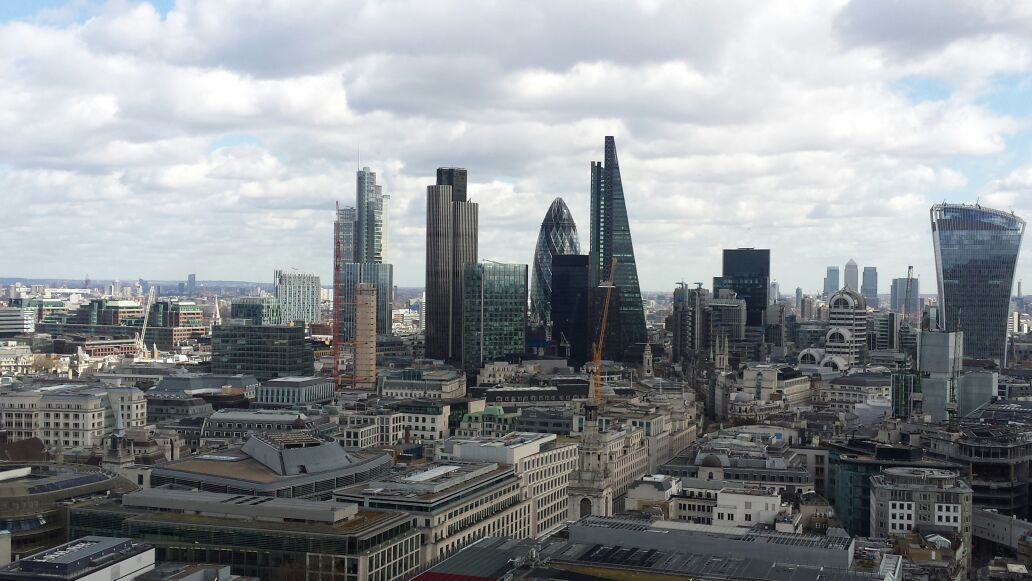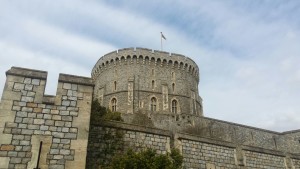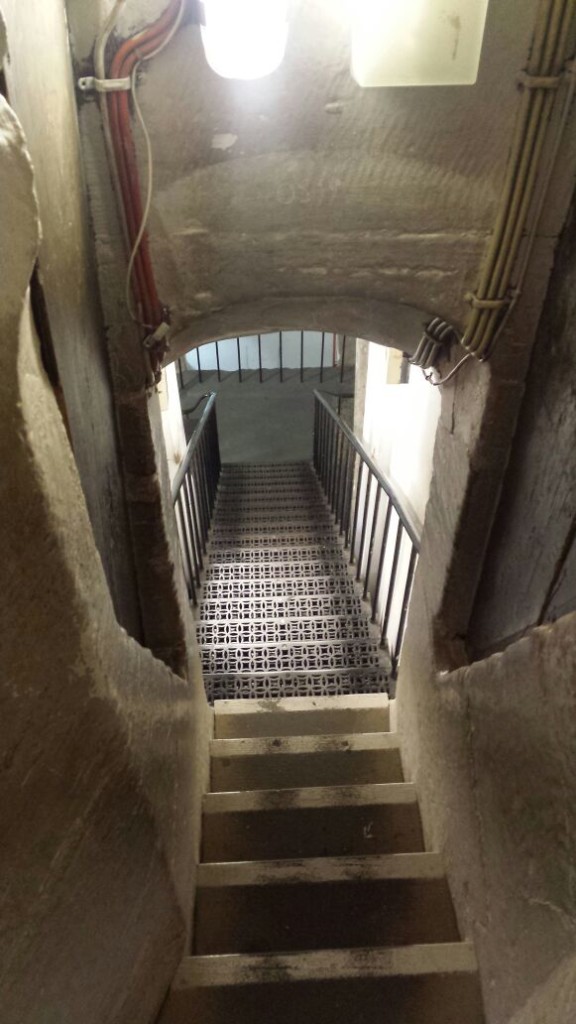
 Welcome to Part 2 of our London and Canterbury Bucket List Challenge update. If you missed Part 1 about Canterbury, you can check it out here. As a quick recap: we took a combined trip to Canterbury and London earlier in April, a three-day, two-night break to make the most of our time and to keep costs down a little.
Welcome to Part 2 of our London and Canterbury Bucket List Challenge update. If you missed Part 1 about Canterbury, you can check it out here. As a quick recap: we took a combined trip to Canterbury and London earlier in April, a three-day, two-night break to make the most of our time and to keep costs down a little.
This isn’t the first time we’ve been to London, and in fact we’ve made a point of doing the ‘tourist thing’ in the past with a visit to The Tower (highly recommended), Harrods, Carnaby Street etc, so choosing what to do in the short amount of time we had was difficult. In the end, we chose as our first port of call, Windsor Castle.
Windsor Castle
 We arrived at Windsor via a short train hop from Slough train station where we’d left the car. It’s possible to drive directly to Windsor village, but given that it was approaching Easter we expected that the car parks might be busy so chose the train as an alternative. It’s a very quick journey with a dedicated line running between Slough and Windsor.
We arrived at Windsor via a short train hop from Slough train station where we’d left the car. It’s possible to drive directly to Windsor village, but given that it was approaching Easter we expected that the car parks might be busy so chose the train as an alternative. It’s a very quick journey with a dedicated line running between Slough and Windsor.
Just ahead of arriving at the station, you get a great view of the castle, set up on the hill and overlooking the fields to one side and the village (which was out of our view) to the other. Windsor village is quaint and was very busy. My over-riding memory is of lots of shops and people, buses and cars and cobbled streets!
From the station it’s just a short walk to the entrance to the castle. We had already bought our tickets online and were able to fast-trak the paying queue and go straight to security. It’s a little like airport security where you need to empty your pockets and put your bags on a conveyor that x-rays the contents while you walk through an alarmed security gate!
Once inside, we collected our complementary audio and headed into the grounds. Tip – take your own earphones!
We were immediately greeted by Prince Charles…no, not in person, but on the audio! The Prince welcomed us to the Castle, reminding us that it’s a living castle, with lots of people living and working there, as well as an ancient and magnificent monument preserved for future generations. The grounds are beautiful but functional, both for modern times with roads to accommodate traffic and for days-gone-by with castle walls exhibiting arrow slits to afford protection during times of conflict.
We immediately noted that the Royal Standard was flying, indicating that the Queen was in residence! There was something quite exciting about knowing that we were so close to the Queen,  even though clearly there was no chance that we were actually going to bump into Her at any point!
even though clearly there was no chance that we were actually going to bump into Her at any point!
After taking a tour around the outside of the Castle, we made our way inside to tour the various rooms opened to the public. Of the many rooms we saw, St George’s Hall stood out as particularly interesting. A long chamber, sumptuously carpeted, the walls and ceiling decorated with carved wooden beams and rare paintings, but most notably for the hundreds of wooden shields depicting coats of arms that decorate the walls and ceilings.
Each coat of arms represents a current of former Knight of the Order of the Garter. Founded in 1348 by Edward III, the Order represents the oldest British Order of Chivalry. Consisting of the Monarch plus 25 knights and honours those who have held public office, served the Monarch or contributed to the nation in some way.
As we looked at the insignia on the walls and ceiling we noticed that some were completely white. These shields belonged to those knights who had been disgraced by crime or treason, for example, Charles I who was executed in 1649.
We were also told (via the audio) that this room had been extensively damaged in the fire that hit the Castle in 1992. The restoration work is striking in the way that it blends with the old effortlessly.
As you can imagine there are many treasures on display at the Castle one of which, is the suit of armour worn by King Henry VIII. The armour is displayed in a glass case and from the front looks ‘normal’, however, move to the side of the display case and it’s possible to see how the sides of the breast plate were extended to accommodate the King’s expanding waistline! It’s details like this that bring the history to life and corroborate the familiar pictures of the robust King!
We spent around four hours at the Castle, so this is just a tiny snippet of the things we saw. There are a number of rooms each with unique and priceless art. The history is fascinating and the treasures well worth the visit. My only disappointment was the lack of ‘modern’ history on display. I would have liked to have seen some pictures, photos or other memorabilia of our most recent Royal family, and, whilst there are pictures of the Queen, these are few, which I felt was a missed opportunity. In some ways it made the visit a little impersonal. But this is a small point, and should not put anyone off from visiting what is a wonderful, living Castle.
London and St Paul’s Cathedral
 After visiting Windsor, we headed to Canterbury where we were staying and the next morning we caught the high-speed train into London. That was a good decision, we loved the train!
After visiting Windsor, we headed to Canterbury where we were staying and the next morning we caught the high-speed train into London. That was a good decision, we loved the train!
In less than an hour we reached St Pancras station, grabbed a coffee from one of the many cafes and then spent the next half an hour trying to work out which tube we needed to get on! For any Londoners (or ex-Londoners) who may be reading, I must admit that we found it a complete mystery and in the end had to ask someone to help! In the end, the journey underground was easy and quick, but frankly, we might still be there if we hadn’t asked for help!
We emerged from the tube to lovely sunshine (we’ve been so lucky with the weather with all our trips so far!) and just a short walk to St Pauls Cathedral. Caught in the sunshine, St Pauls is like a massive porcelain white megalith, trapped between modern glass buildings and endlessly noisy traffic.
The current St Pauls is the fifth cathedral to have been built on the site, the first having been founded in AD604. None of the previous structures survived, the previous (fourth) cathedral having been gutted by the Great Fire of London in 1666.
We climbed the steps, famously climbed by Lady Diana Spencer on her wedding day to Prince Charles, and entered the Cathedral. As with previous attractions, we were given a complementary audio which would guide us around the huge building. Even while we were there, services were being conducted. Tourists mingled with pilgrims who mingled with regular parishioners, but the mix worked well and felt comfortable.
Designed by Sir Christopher Wren, St Pauls stands out for its appearance of wealth. Compared to other cathedrals that we’ve visited, St Pauls has the most ornate and golden ceilings. There are many beautiful mosaics which glitter in the light. We were told (via the audio) that the mosaics are made of individual pieces of glass, which explains why they reflect the light so well.
Of course, no visit to St Pauls would be complete without the climb to the Whispering Gallery. The Gallery sits in the dome, some 259 steps from ground level. We climbed the winding stair case, which became narrower and narrower until we reached a corridor that led out to the Gallery. For those of you that know me, you will already know that I’m not a fan of heights and so this was quite a challenge for me. The view back down to the floor of the cathedral is splendid, but, frankly this was where my bravery crumbled and I made a hasty retreat back down the winding stair case!
from ground level. We climbed the winding stair case, which became narrower and narrower until we reached a corridor that led out to the Gallery. For those of you that know me, you will already know that I’m not a fan of heights and so this was quite a challenge for me. The view back down to the floor of the cathedral is splendid, but, frankly this was where my bravery crumbled and I made a hasty retreat back down the winding stair case!
Luckily my braver hubby continued the climb from the Gallery, until he was able to step outside on to the roof of St Pauls. It’s thanks to him that we have the shots of the London skyline!
The Cathedral is the final resting place of many notable and famous people. Beneath the Cathedral is a crypt which covers the same floor area as the structure above (which is unusual for a church and is the biggest in Europe). In the crypt are many burials and memorials, the first burial having been that of Sir Christopher Wren in 1723. The crypt also houses the tomb of Lord Horatio Nelson and the Duke of Wellington, although a tribute to Wellington is also displayed in the Nave (at ground level) in the form of Wellington on his horse, Copenhagan.
After spending a few hours exploring the Cathedral, we decided to have some lunch in situ. Unusually, the café is located underground in the crypt and we ate amongst the memorials of past parishioners!
There is much, much more I could write about our visit to St Pauls, but in the interests of brevity(!), I’ll let the pictures tell the rest of the story. But, if you have the opportunity, then a visit to St Pauls is definitely worth the effort.
So there you have it! We have now visited 5 cities in our Visit 12 UK Cities in 12 Months Bucket List Challenge! I’m excited that we have managed to keep to our plan and have had fun, learned lots and enjoyed ourselves into the bargain.
Our next city is…well, you can find out next month when I’ll share our latest adventure with you!
To check out our earlier trips, click below:




[…] to Liverpool. The twelve cities we visited were: Bristol, Gloucester, Salisbury, Wells, Canterbury, London, Lincoln, St David’s, Worcester, Edinburgh, London (again!) and […]